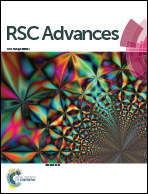Theoretical study on the mechanism, chemo- and enantioselectivity of the Ag- vs. Rh-catalyzed intramolecular carbene transfer reaction of diazoacetamides†
Abstract
To explore the mechanism of silver and rhodium catalysis and reveal the origin of the chemo- and enantioselectivity of the reaction, density functional theory calculations were performed on the first silver-catalyzed highly enantioselective carbene transfer reaction. The calculation results reveal that when silver is used as a catalyst, due to the participation of the phosphate anion in the transition state, the enhanced nucleophilicity of the α-diazoacetamide unit promotes smooth dearomatization before generation of the silver carbene. Because the generated rhodium carbene has stronger electrophilicity, typical carbene reactions (C–H insertion and the Büchner reaction) are favored. In addition, in the process of silver catalyzed dearomatization, the formation of an R-type transition state is determined by the small torsion energy and strong interaction energy.



 Please wait while we load your content...
Please wait while we load your content...